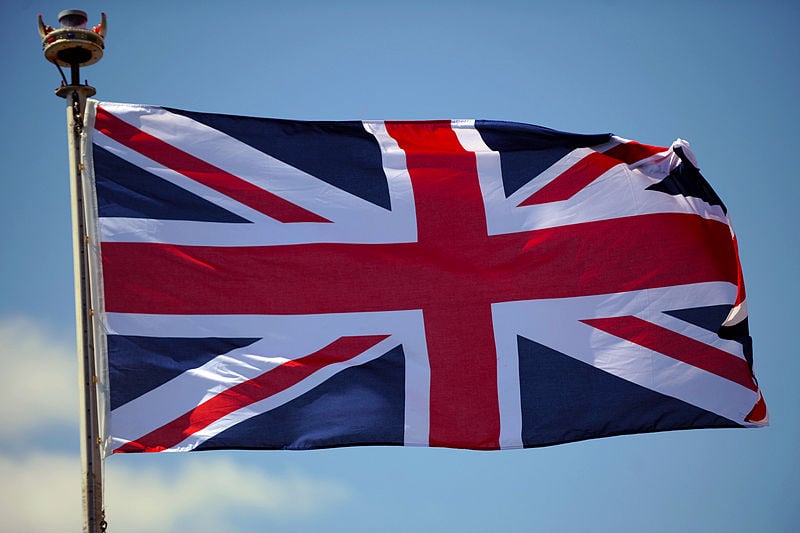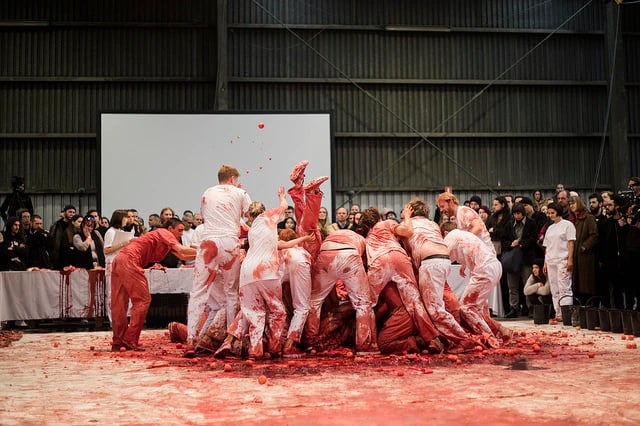Art World
An Australian Arts Festival Has Canceled Artist Santiago Sierra’s Plans to Douse the British Flag in the Blood of Indigenous People
The Dark Mofo festival pulled the work after outcry from Indigenous groups.

The Dark Mofo festival pulled the work after outcry from Indigenous groups.

An Australian museum has cancelled plans to show a controversial art project by Spanish artist Santiago Sierra that would have involved immersing the British flag in blood donated by Indigenous people.
The Dark Mofo arts festival, which is run by the Museum of Old and New Art in Hobart, Tasmania, has pulled the work, which was intended as a statement “against colonialism,” after Indigenous artists around the country decried the work, along with the National Visual Arts Association, several MONA staff members, and other members of the Australian art community.
“This is an insulting and abhorrent curatorial decision. There has been enough First Peoples blood spilt across the world because of the English,” wrote Kimberley Moulton, the senior curator for Museums Victoria, in a private Instagram post quoted by the Guardian. “This is not ‘decolonizing,’ it’s not provocative or groundbreaking conceptual practice… it’s shock jock art.”
“The invitation to donate blood to this project is disrespectful and ignorant,” wrote Cass Lynch, of the Aboriginal Noongar people, in Overland magazine. “To ask First Nations people to give blood to drench a flag recreates, not critiques, the abhorrent conditions of colonzation.”
A coloniser artist intending to produce art with the actual blood of colonised people is abusive, colonising and re-traumatising. The idea is disgusting and terrible and should not have been considered. Please don’t.
— Claire G. Coleman (@clairegcoleman) March 21, 2021
“A colonizer artist intending to produce art with the actual blood of colonized people is abusive, colonizing and re-traumatizing. The idea is disgusting and terrible and should not have been considered. wrote writer Claire G. Coleman, who is of the Aboriginal Noongar people, on Twitter. “Please don’t.”
Dark Mofo had announced the performance, titled Union Flag, over the weekend in putting out the call for Indigenous people to donate their blood.
As the backlash mounted, Dark Mofo creative director Leigh Carmichael initially attempted to stand by the work, issuing a Facebook statement that said the festival had had conversations beforehand with Tasmanian Aboriginal people and that “self-expression is a fundamental human right, and we support artists to make and present work regardless of their nationality or cultural background.”
But staff at MONA, which operates separately from Dark Mofo, also expressed their disapproval for the work, both in messages on Instagram and in a letter to the museum’s founder, art collector and professional gambler David Walsh.
At that point, organizers called the performance off. “In the end, the hurt that will be caused by proceeding isn’t worth it,” wrote Carmichael in a Facebook post. “We made a mistake, and take full responsibility. The project will be cancelled. We apologize to all First Nations people.”
In a statement posted on the museum’s website and social media channels, Walsh, identifying himself as the “archetypal beneficiary of colonialism,” addressed the controversy: “Had all this gone swimmingly: blood collected, naff anti-colonial point made, feedback positive, who would have benefited? Not First Nations people. They already know they’ve been fucked over by colonialism. Who then? MONA? Me. That’s me drinking the milkshake. It’s no wonder everyone is disgusted. I’m sorry.”
This isn’t the first time scandalizing artworks have gotten Dark Mofo in trouble. In 2017, animal rights activists protested ahead of Hermann Nitsch’s three-hour performance piece 150.Action, which features 500 liters of blood and a slaughtered bull. The work ultimately went ahead as scheduled.

Hermann Nitsch, 150.Action at Dark Mofo in 2017. Photo courtesy of Dark Mofo/Lusy Productions.
Sierra has also courted controversy in many of his previous works, which have included tattooing heroin-addicted sex workers and filling a deconsecrated German synagogue with carbon monoxide and having visitors walk through wearing gas masks. Among his proposals for Dark Mofo was a piece involving a “huge amount of cocaine,” Carmichael told Australian news outlet ABC.
The artist intended Union Flag as an “acknowledgement of the pain and destruction colonialism has caused First Nations people, devastating entire cultures and civilizations,” Sierra said in a statement on ABC. Indigenous Australians have “suffered enormously and brutally from British colonialism, nowhere more so than in Tasmania where the Black War in the early 19th century had a devastating impact, almost killing the entire Tasmanian Aboriginal population—an act that has since been defined as genocide.”
Dark Mofo is on view at the Museum of Old and New Art in 655 Main Road, Berriedale, Tasmania, June 16–22, 2021.